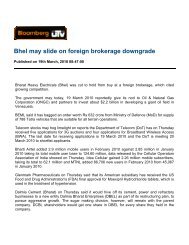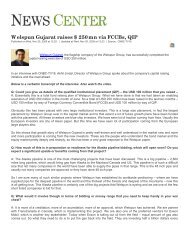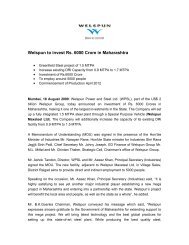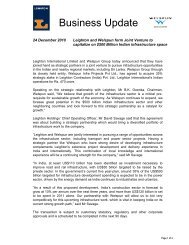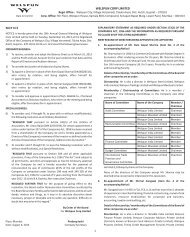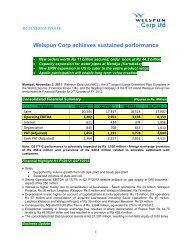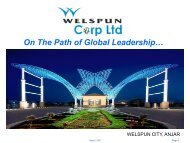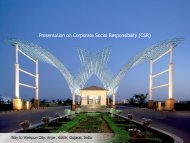Create successful ePaper yourself
Turn your PDF publications into a flip-book with our unique Google optimized e-Paper software.
th15 <strong>Annual</strong> <strong>Report</strong> <strong>2009</strong>-<strong>10</strong>6. Depreciationa) In case of parent, depreciation on fixed assets is provided on Straight Line basis at the rates prescribed in Schedule XIV to theCompanies Act, 1956 except for certain plant and machinery which are depreciated on the basis of estimated useful lives of13- 15 years. The rates of depreciation derived from these estimated useful lives are higher than those given in Schedule XIVto the Companies Act, 1956.b) In case of subsidiaries / Joint ventures depreciation is provided at the rates adopted in the accounts of respective subsidiaries/ Joint ventures as permissible under applicable local laws on straight line basis except in the case of a joint venturedepreciation is provided on Written Down Value Method the net book value of such assets as at 31 March 20<strong>10</strong> is Rs. 1.22million (Rs. 1.23 million).c) For determining the appropriate rate of depreciation on Plant and Machinery, continuous process plant has been identifiedon the basis of technical opinion by the Company/ Expert.d) Software is amortized over a period of five years from the date of its use based on management's estimate of useful life.7. InvestmentsInvestments intended to be held for more than a year, from the date of acquisition, are classified as long term and are carried atcost. Provision for diminution in value of investments is made to recognize a decline other than temporary. Current Investmentsare stated at cost or fair value which ever is lower.8. Revenue Recognitiona) Sale of goods is recognized when the risks and rewards of ownership are passed on to the customers, which is generally ondispatch. Export Sales are accounted for on the basis of date of bill of lading. Gross Sales include excise duty, value added taxincentive, quality claims, adjustments for price variation, liquidated damages, exchange rate variations related to exportrealization.b) Export benefits: Duty Entitlement Pass Book (DEPB) and Focus Market are accounted on accrual basis. Target plus /Duty FreeEntitlement Certificate scheme of EXIM policy are recognized when utilized.c) Revenue from Services is recognized when the services are completed.d) Dividend income is recognized when the right to receive the dividend is unconditional.9. InventoriesInventories are valued at lower of cost or net realizable value. The basis of determining cost for various categories of inventories isas follows:-(I) Raw Materials, Stores and Spares Moving weighted average basis.(II) Work / Goods in Process and Finished Goods- Cost of Direct Materials, Labour and other manufacturing expenses.<strong>10</strong>. (i) Foreign Currency TransactionsAccounting of Transactionsa) Foreign exchange transactions are converted into Indian Rupees at the prevailing rate on the date of the transactions. Currentmonetary assets and liabilities are translated at the exchange rate prevailing on the last day of the year. Non monetary itemsare carried at cost.b) Gains or losses arising out of remittance / translations at the year- end are credited / debited to the profit and loss account forthe year and where it relates to acquisition of fixed assets are adjusted to the carrying cost of such assets except treatment asper amendment to AS-11 (Refer note no <strong>10</strong> (ii)).c) Premium / discount on forward exchange contracts not relating to firm commitments or highly probable forecastedtransactions and not intended for trading or speculation purpose is amortized as income or expense over the life of thecontract.Translation and Exchange RatesFinancial statements of overseas non-integral operations are translated as under:a) Assets and Liabilities are translated at the exchange rate prevailing at the end of the year. Depreciation is accounted by takingsame rate at which assets are converted.b) Revenues and expenses at yearly average rates (except for inventories which are converted at opening / closing rates as thecase may be). Off Balance Sheet items are translated into Indian Rupees at year-end rates.c) Exchange differences arising on translation of non-integral foreign operations are accumulated in the Foreign CurrencyTranslation Reserve until the disposal of such operations.96



